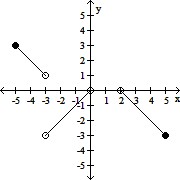Find the inverse of the function.
A. 
B. 
C. 
D. 
Answer: A
You might also like to view...
Find the open intervals on which the function is increasing and decreasing. Identify the function's local and absolute extreme values, if any, saying where they occur.
A. increasing on (-3, 0); decreasing on (-5, -3) and (2, 5) absolute maximum at (-5, 3); local maximum at (0, 0) and (2, 0); absolute minimum at (5, -3) B. increasing on (-3, 1); decreasing on (-5, -3) and (0, 5) absolute maximum at (-5, 3); no absolute minimum C. increasing on (-3, 0); decreasing on [-5, -3) and (2, 5] absolute maximum at (-5, 3); absolute minimum at (5, -3) D. increasing on (-3, 0); decreasing on (-5, -3) and (2, 5) absolute maximum at (-5, 3); local minimum at (-3, -3) and (5, -3)
Solve.9x = -18
A. 27 B. -27 C. 1 D. -2
Find the total surface area and volume of the solid object. (Round to the nearest whole number and use the ? key for ?.)
A. T = 108 cm2, V = 83 cm3 B. T = 62 cm2, V = 62 cm3 C. T = 62 cm2, V = 83 cm3 D. T = 108 cm2, V = 62 cm3
Solve the equation by multiplying both sides by the LCD.x - 5 = 
A. {-6, 1}
B. 
C. 
D. {-1, 6}